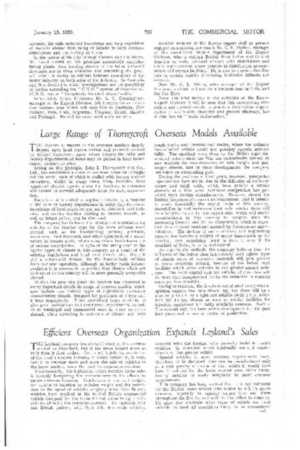Efficient Overseas Organization Expands Leyland's Sales
Page 85

Page 86

If you've noticed an error in this article please click here to report it so we can fix it.
THE Leyland company has alwayi looked on the overseas market as important, but it has never looked more so -to it than it does to-day. Continued legislative restriction of the road transport industry in Great Britain is, it feels, bound to decrease more and more the sale of vehicles in the home market; hence the need for expansion overseas.
Unfortunately, this legislation which restricts home sales is severely hampering the manufacturer in his efforts to secure overseas business. Limitations in size and weight, the system of taxation by unladen weight and the restriction on the speed of vehicles weighing more than 50 cwt. unladen have resulted in the typical British commercial vehicle designed for the home market alone being unsuitable for all but a few countries overseas. For instance, how can British makers, with their 7-ft, 6-in.-wide vehicles, compete with the foreign, who normally build 8-ft.-wide vehicles, in countries which habitually use and require chassis of this greater width?
Special vehicles to meet overseas requirements have, therefore, to be designed; they can be manufactured only at a cost greatly in excess of that which it would have been if vehicles for the home market were either immediately suitable or easily adaptable to meet overseas requirements.
This company has long realized that it is not sufficient for the British manufacturer who wishes to sell his goods overseas, hopefully to appoint agents here and there throughout the Empire and wait for the orders to come in. He must first ascertain what types of vehicle are most suitable to meet all conditions likely to be encountered overseas and then make arrangements for the production of his overseas range. He must build up an adequate selling organization, and, what is even more important, be must establish adequate service facilities which will ensure that his vehicles will give the performance and life expected of British engineering products. When the overseas organization is built it must not be allowed to become stagnant; it must maintain continual personal contact with the organization at home.
Accordingly, Leyland directors and officials frequently make overseas tours; since the War few months have elapsed during which there has not been some representative of the company away on work of this character. At present Mr. Henry Spurrier, jnr., a director, is away on a six months' trip; he will be visiting, amongst other places, U.S.A., Canada, New Zealand, Australia, India and Egypt.
Not long ago the chief designer in the railcar department spent some months in New Zealand and Australia working in co-operation with Government railways there on the design of railcars which the railways contemplated building and in which our 'units are now being installed.
Visits such as these help to keep the factory informed of any changing requirements of overseas operators, and enable designers to interpret their wants intelligently. For example, an extended visit by one of our technical staff to the Iranian oilfields was largely responsible for the development of a special overseas two-axles] chassis for carrying 2,375 gallons of petrol; as a result of the performance of this vehicle there are nearly 400 machines like it in service there to-day.
In the building of our sales and service organizations our guiding principle is to set up our own branches under the control of men who have Leyland factory experience, and to back up these managers, so far as possible, by factory-trained staff. Loyalty and enthusiasm are among the company's "invisible exports." The, first overseas branches in Sydney and Wellington were opened as early as 1919, and were quickly followed by others, until to-day there are branches and agents throughout the Empire, as well as in other parts of the world. Leyland signs over premises are to be seen, for example, in Lourenco Marques (South Africa), Kuala Lumpur .(Malay States) and Trinidad. An Iranian operator in Teheran can get Leyland spares just as quickly and easily as can a Manchester customer.
Another move in the campaign to develop overseas trade is the system of maintaining an adequate supply of men especially trained for overseas service. In conjunction with its factories are run schools for the training of apprentices. At the conclusion of their apprenticeships young men who have shown by their work and conduct that they are likely to be suitable for overseas appointments are earmarked, and as the opportunities occur they are offered temporary appointments on the staff abroad.
It may be that the individual, when abroad, shows promise, in which case, in all probability, he will remain there. On the other hand, he may prove his worth but find no appointment immediately available, so that he has to be brought home until a vacancy abroad occurs. In either case he has gained valuable experience. In this way the company has managed to create a reserve of staff for overseas work with its own branches, with its agents, or, as often happens, with the larger transport concerns operating Leyland vehicles, In short, what is being done is to keep in constant touch with overseas requirements by periodical personal visits, to have Leyland men permanently on the spot where possible, and to provide by specialized training a band of young men with the necessary knowledge to help operators to get the best out of their vehicles. As a direct result, sales in overseas countries have shown the remarkable increase of 400 per cent, in the past six years. During that just completed the value of the export sales approximated 15 per cent, of the total made in the home market,




















































































































































